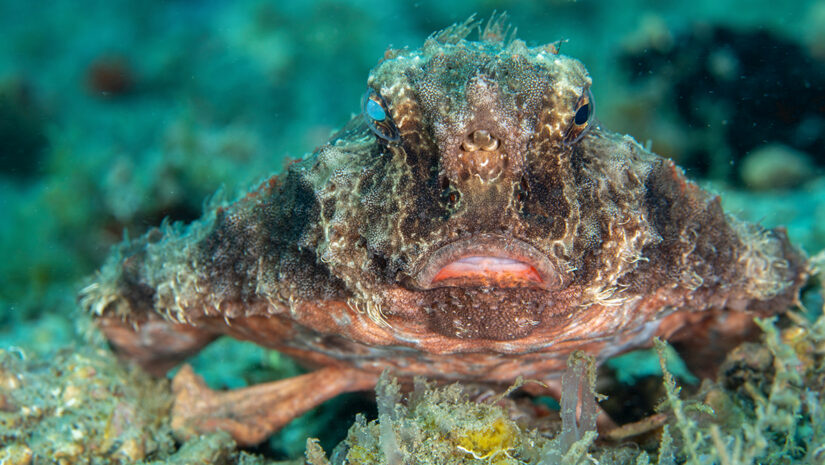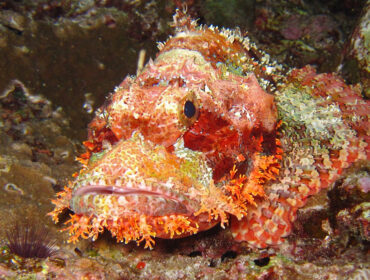Picture yourself scuba diving, hovering just above the seafloor, when you notice a slight disturbance in the sand ahead. At first, you might think it’s a ray, but then you see a creature crawling along the bottom on what appears to be feet. Even stranger, it seems to be wearing lipstick! Fellow divers, you are not hallucinating due to nitrogen narcosis; you’ve just encountered a bottom-dwelling batfish, sometimes called an anglerfish.
Batfish belong to the Ogcocephalidae family and are closely related to the anglerfish. They should not be confused with the more commonly seen batfish from the Ephippidae family. Which are disc-shaped or spade-shaped and often follow scuba divers around. The Ogcocephalidae batfish include several species of bottom-dwelling fish typically found in the deeper regions of the Atlantic, Indian, and Western Pacific Oceans.
These fishes are flat and often triangular, resembling rays. The largest species can grow up to 20 inches long. They lure their prey using a lure attached to their heads. They feed primarily on bottom-dwelling invertebrates, which are attracted while buried in the sand.
It’s a genuinely bizarre creature that could walk on land if it wanted to. They are specially adapted for a bottom-dwelling life. In many species, the pelvic and anal fins are thick and stout, providing support on the substrate. They can walk along the bottom using their large, arm-like pectoral fins. Plus, they have smaller pelvic fins, although they are not strong swimmers.
There are several species, including the Red-lipped Batfish (Ogcocephalus darwini), Rosy-lipped Batfish (Ogcocephalus porrects), Shortnose Batfish (Ogcocephalus nasutus), Brazilian Batfish (Ogcocephalus vespertilio), and Roughback Batfish (Ogcocephalus parvu). Each species has slightly different physical characteristics and can be found in various waters.
Batfish Identification
These fish are a favorite among scuba divers, often showing a high level of curiosity and coming close to a diver’s face to investigate. They frequently accompany diver groups throughout the entire dive, curiously circling them. Such fish are known as excellent companions during safety stops, as they often hover mid-water, just below the surface, watching divers.
Fun fact: They are also known as spadefish and are scientifically classified as Ephippidae. It’s important to note that there are two other types of fish called batfish. We explicitly refer to the large, round, laterally compressed, silvery fish with small mouths, typically featuring black and sometimes yellow markings.
Ephippidae, or batfish, primarily inhabit the Atlantic, Pacific, and Indian Oceans. While most species are marine, some can also be found in brackish environments. They consume seaweed that other herbivorous fish tend to avoid, making them an integral part of the coral reef ecosystem. Some species, particularly the Zebra Batfish, can grow up to two and a half feet long.
There are over 20 different species, but some of the more common ones include:
Tall-fin Batfish (Platax teira)
One of the most commonly seen by divers, they can be identified by their steep heads and a large black patch on their belly near the ventral fin. Tall-fin Batfish can grow up to 70 cm (2.3 feet) and have a boomerang shape when they are younger, becoming more prominent and rounder as they mature.
Round Batfish (Platax orbicularis)
Also known as the circular spadefish, Round Batfish are large, featuring two vertical black bars on their heads, with fin edges fading into a golden-yellow color. They can grow up to 60 cm (2 feet) in length. Juveniles have a brownish “dead leaf” coloration that helps them mimic dead leaves floating in the current until maturity.
Shaded Batfish (Platax pinnatus)
This mysterious, solitary fish is primarily found in the Western Pacific. They often hide in shipwrecks or dark areas and are rarely seen in groups. Unlike their more inquisitive cousins, shaded Batfish tend to shy away from divers. They can be identified by their distinctive protruding snout and prominent lips. Juveniles are easily spotted due to their striking all-black coloration, with a perfect orange ring around the edges of their fins.





